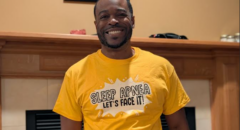 Narcolepsy is a chronic sleep disorder that makes you feel overwhelmingly tired. Symptoms may include excessive daytime sleepiness, cataplexy, sleep paralysis, hypnogogic hallucinations, disrupted nighttime sleep and even depression. Per experts, some may experience what’s called a sleep attack – an extreme tendency to crash whenever in relaxing surroundings.
Narcolepsy is a chronic sleep disorder that makes you feel overwhelmingly tired. Symptoms may include excessive daytime sleepiness, cataplexy, sleep paralysis, hypnogogic hallucinations, disrupted nighttime sleep and even depression. Per experts, some may experience what’s called a sleep attack – an extreme tendency to crash whenever in relaxing surroundings.
Although the disorder may not come up in everyday conversation, believe it or not, it affects an estimated 1 in every 2,000 people in the United States. That's 200,000 Americans, and approximately 3 million people worldwide. Shockingly, the Narcolepsy Network reports that only an estimated 25 percent of people who suffer from the sleep disorder have been diagnosed and are receiving treatment.
Of course, the disparity between diagnosis and treatment may be due to the complexity of the disease. Everyone with narcolepsy has excessive daytime sleepiness (EDS), according to the site FeelingTheFog.com. However, not everyone experiences narcolepsy the same way. There are two types of narcolepsy: narcolepsy with cataplexy (type 1) and narcolepsy without cataplexy (type 2).
So, to help you better understand the two, BlackDoctor.org recently spoke with Dr. Kyra Clark, a board-certified expert in sleep medicine and Medical Director of Sleep Diagnostics at Morehouse School of Medicine, who broke down the difference between the two types of narcolepsy.
Narcolepsy with Cataplexy: Type 1
The National Sleep Foundation (NSF) defines cataplexy as, "a sudden and uncontrollable muscle weakness or paralysis that comes on during the day and is often triggered by a strong emotion, such as excitement or laughter." Without warning, the person loses muscle tone in their body may experience total weakness in their face, arms and legs. "A person experiencing total cataplexy stays awake and is aware of what is happening, but cannot move," states the NSF.
Dr. Clark explained, “The diagnosis of narcolepsy is just not made on symptoms. It also requires sleep testing to include polysomnography and multiple sleep latency tests.”
For type 1 narcolepsy, as defined by the International Classification of Sleep Disorders, the following three criteria must be present: type 1-excessive daytime sleepiness for at least 3 months AND has to at least have one or both of the following:
- cataplexy with a mean sleep latency of 8 minutes or less and 2 sleep onset rapid eye movement periods on multiple sleep latency tests (MSLT)
- low cerebrospinal fluid (CSF) hypocretin 1 concentration (usually 110 pg/ml or less)
Narcolepsy without Cataplexy: Type 2
To diagnose type 2 narcolepsy, Dr. Clark explained that testing would show, “Excessive daytime sleepiness for at least 3 months AND a mean sleep latency of 8 minutes or less and 2 sleep onset rapid eye movement periods on multiple sleep latency tests (MSLT). There would also be an absence of cataplexy and cerebrospinal fluid (CSF) is not measured or if measured hypocretin 1 concentration >110 pg/ml. Also, the sleepiness cannot be explained by other causes.
Fortunately for those who believe they may be suffering from the chronic sleep disorder, Clark offered up a handful of helpful tools to “self-diagnose” before seeking professional medical help (if needed). For more information on narcolepsy as well as a screening tool, visit FeelingTheFog.com.
To contact Dr. Clark directly, locals can visit her practice at Morehouse Healthcare (two locations), 1800 Howell Mill Road, Suite 275 Atlanta, GA 30318 202-756-1400 and 1513 East Cleveland Ave, Building 500, East Point, GA 30344 or give her a ring at 404-752-1000.









